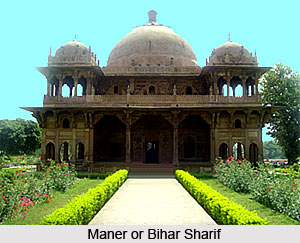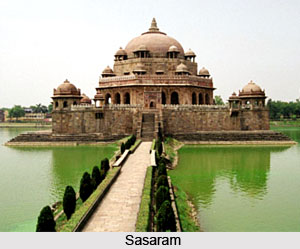 Patna, regarded as a most integral part in the present state of Bihar, serving as its capital, has been in the historical limelight in India, since the name of the place was Pataliputra during Buddhist and Hindu times. With time however, it had come to seize sufficient importance during Mughal times too, with men like Akbar, Jahangir, Shah Jahan and Auranzgeb trying to establish their stronghold in Bihar in order to secure a well-made position in eastern India. In this context comes in the independent existence of Patna`s architecture during Jahangir, which was indeed much massive in comparison to other places like Sasaram, Maner or Bihar Sharif. Quite as an expected consequence, architecture of Patna under Jahangir deserves to be specially stated as an `autonomous` Mughal architectural excellence in a Mughal Bihar.
Patna, regarded as a most integral part in the present state of Bihar, serving as its capital, has been in the historical limelight in India, since the name of the place was Pataliputra during Buddhist and Hindu times. With time however, it had come to seize sufficient importance during Mughal times too, with men like Akbar, Jahangir, Shah Jahan and Auranzgeb trying to establish their stronghold in Bihar in order to secure a well-made position in eastern India. In this context comes in the independent existence of Patna`s architecture during Jahangir, which was indeed much massive in comparison to other places like Sasaram, Maner or Bihar Sharif. Quite as an expected consequence, architecture of Patna under Jahangir deserves to be specially stated as an `autonomous` Mughal architectural excellence in a Mughal Bihar.
Sadly though, in Patna, as in many cities that still retain their medieval importance, very few buildings of early Mughal date remain. The continuous process of urbanisation has replaced them. Only two early Mughal monuments in Patna`s architecture during Jahangir are worthy of comment, both characteristic of styles more widely witnessed in Bihar. The first instance is Mirza Masum`s mosque, inscribed as a Jami mosque and constructed between 1614-15 and 1616-17. Mirza Masum had entered imperial service during Emperor Akbar`s reign and then had served in Bengal under Jahangir`s governor, Islam Khan. Evidently, Mirza Masum had left Bengal after Islam Khan`s demise in 1613 and had retired to Patna, where he had constructed a mosque and also a market. Mirza Masum indeed was the most praiseworthy instance in architecture of Patna under Jahangir, building in his own accord being patronised by such a Mughal man.
 Mirza Masum`s mosque is a less refined version of Shaikh Farid Bukhari`s mosque built in Bihar Sharif in 1608. The engaged columns flanking the central bay rise above the central pishtaq - a feature characteristic of umpteen mosques in Patna and elsewhere in eastern India. Net patterns rendered in stucco appear in the central mihrab`s soffit and again in the vaulting. This is the earliest recognised use of net patterning in stucco on an eastern Indian mosque that too executed in Patna`s architecture during Jahangir, although the technique is visible earlier in parts of the Rohtas palace.
Mirza Masum`s mosque is a less refined version of Shaikh Farid Bukhari`s mosque built in Bihar Sharif in 1608. The engaged columns flanking the central bay rise above the central pishtaq - a feature characteristic of umpteen mosques in Patna and elsewhere in eastern India. Net patterns rendered in stucco appear in the central mihrab`s soffit and again in the vaulting. This is the earliest recognised use of net patterning in stucco on an eastern Indian mosque that too executed in Patna`s architecture during Jahangir, although the technique is visible earlier in parts of the Rohtas palace.
The second surviving Mughal monument in Patna and its related architecture during Jahangir, is the f, built by Nazar Khwishgi in 1626-27. Nazar Khwishgi is best known for his stellar career under Shah Jahan, but during Jahangir`s reign he was a close attendant of Prince Parvez, one of Jahangir`s sons. Parvez was governor of Bihar, but never actually had travelled there; in all probability, Nazar Khwishgi had served as his deputy.
Patthar-ki Masjid`s east facade is stucco faced and adheres to the formula already witnessed in all Mughal mosques in Bihar. The other three sides, however, are stone-faced, nearly the last utilisation of stone for a building`s facade in either Bengal or Bihar. The stone is carved with small floral medallions and slender-necked wine flasks, a motif much visible upon contemporary monuments at the centre, but rarely in eastern India. It is indeed a matter of much interest and arrest that eastern Indian architecture under the Mughal Empire, with special stress in Bihar and Bengal was hugely unlike and dissimilar from the insignia architectural pattern in Agra or Delhi - the premiere Mughal bases and architectural wonders, that any man can conceive of. Practically every kind of Mughal architectural pattern was altered and modified in places like Bihar, with locally favoured architecture being accentuated mostly. As a result, architecture in Patna during Jahangir was mostly espoused and embraced in such indigenous construction and further modification was held therein.



















